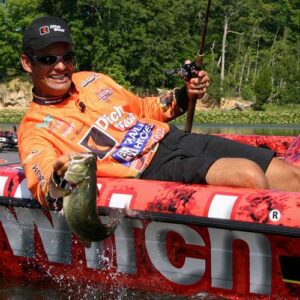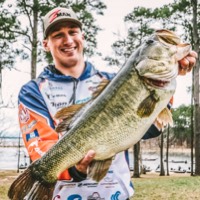- BassEdge.com - Pursue Your Passion
Fishing In Hot Water By Aaron Martin
THE EDGE – Episode 237 – Wesley Strader
August 1, 2016THE EDGE – Episode 238 – Matt Reed
August 15, 2016
Lessons learned on childhood summer days last a lifetime.
Throughout my youth, summer days were spent walking the banks of the ponds on the family property and wading down local streams. It wasn’t so much the fishing that drew me to the tepid waters as much as an alternative to the chores around the farm. Little did I realize the long-term impact these childhood escapes would have on me later in life.
Those early years taught me the importance of cover and water quality when searching for late summertime bass, but most of all it instilled in me at an early age a confidence that bass could be caught in the hottest part of the year.
“I have heard it said many times that fish won’t bite when it’s this hot,” FLW Cup contender Jack Wade said. “Some of my best outings have been during the hottest part of the day.”
When searching out the haunts of summer bass, Wade spends ample time watching his electronics looking for humps, drop-offs and ledges — all with plenty of cover. He stresses that topographical features create the perfect ambush point for bass to attack prey while the grass lines and timber offer security and shade.
Wade likes reservoirs with both grass and timber.
“I like to find small areas that are close to a point or ledge with a submerged grass bed and a few surrounding trees, then pick the area apart.”
Concentrating on depths of 15 to 20 feet, Wade presents his 1 ¼-ounce jig into the submerged grass that tops out about five feet off of the bottom. Making short casts, he is able to work his bait more vertically, generating a reaction strike when the jig pounds the bottom. Fishing the bait all the way back to the boat allows him to thoroughly fish the isolated grass. He is likely to compliment his bottom-focused approach by winding a large one-ounce, shad-colored spinnerbait as well.
“I like to slowly bring the spinnerbait across the top of the submerged grass and along the sides of pole timber. When a fish does hookup, it is likely to be a good one.”
Key structure and proper bait selection aren’t the only factors Wade depends on for a successful day on the water. Each morning he pulls out a small note-size piece of paper, a sort of schedule which lists the order he will fish his spots as well as the time he needs to be at each. Besides serving as a time-management tool, the main reason of his time-specific arrivals and departures are based around the major and minor solunar periods.
While bass stage in deeper water during warmer months, there are also fish residing in the shallows, as FLW Cup qualifier Bud Pruitt knows too well.
During preparation for a recent tournament on Arkansas’ Lake Ouachita, Pruitt located numbers of quality fish holding along a creek channel lined with grass.
“It’s an area that has a defined edge in which the bass can move up out of the channel and stage in the grass.”
With high skies, temperatures reaching into the 90s and a falling lake level, the bass related to the outer edge of the shallow grass line. Keeping his boat in seven to nine feet of water and following the contour of the grass, Pruitt got most of his strikes three to four feet inside the grass line. After working the area in front of the boat with a surface popping bait and frog, he would switch to a Texas-rigged, cotton candy crawbait with a pegged quarter-ounce sinker to probe open spots in the vegetation.
“I look for grass that has space underneath so that the bass have room to move.”
Without spending much time on each presentation, he quickly redirects his bait to the next hole while maintaining a steady pace with the trolling motor.
Wade’s rods appear to be fit for reinforcing concrete on any government road project, with heavy action and plenty of backbone throughout the entire seven-foot rod. Although it may seem a bit on the stout side, I saw for myself the effectiveness of his equipment as he pulled large bass out of a cedar tree in 18 feet of water.
Pruitt on the other hand takes a more conventional approach selecting a heavy action grass rod with a fast tip to facilitate strike detection while using more compact baits. Regardless of the application, targeting late summer bass can be just as intense as the mercury registering on the thermometer and certainly worth skipping daily chores.


